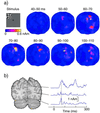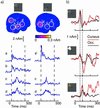Coinciding early activation of the human primary visual cortex and anteromedial cuneus
- PMID: 11226316
- PMCID: PMC30215
- DOI: 10.1073/pnas.041600898
Coinciding early activation of the human primary visual cortex and anteromedial cuneus
Abstract
Proper understanding of processes underlying visual perception requires information on the activation order of distinct brain areas. We measured dynamics of cortical signals with magnetoencephalography while human subjects viewed stimuli at four visual quadrants. The signals were analyzed with minimum current estimates at the individual and group level. Activation emerged 55-70 ms after stimulus onset both in the primary posterior visual areas and in the anteromedial part of the cuneus. Other cortical areas were active after this initial dual activation. Comparison of data between species suggests that the anteromedial cuneus either comprises a homologue of the monkey area V6 or is an area unique to humans. Our results show that visual stimuli activate two cortical areas right from the beginning of the cortical response. The anteromedial cuneus has the temporal position needed to interact with the primary visual cortex V1 and thereby to modify information transferred via V1 to extrastriate cortices.
Figures




References
-
- Felleman D J, Van Essen D C. Cereb Cortex. 1991;1:1–47. - PubMed
-
- Schmolesky M T, Wang Y, Hanes D, Thompson K G, Leutgeb S, Schall J D, Leventhal A G. J Neurophysiol. 1998;79:3272–3278. - PubMed
-
- Schroeder C E, Mehta A D, Givre S J. Cereb Cortex. 1998;8:575–592. - PubMed
-
- Orban A G. In: Cerebral Cortex. Rockland K S, Kaas J H, Peters A, editors. Vol. 12. London: Plenum; 1997. pp. 359–434.
-
- Schall J D. In: Cerebral Cortex. Rockland K S, Kaas J H, Peters A, editors. Vol. 12. London: Plenum; 1997. pp. 527–638.
Publication types
MeSH terms
LinkOut - more resources
Full Text Sources

